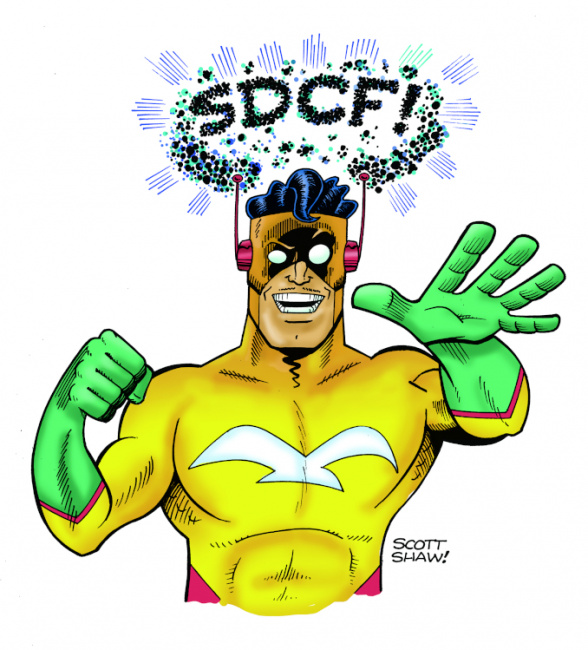Last weekend, San Diego welcomed back its "other" comic convention, the wonderfully intimate San Diego Comic Fest, which had been founded a decade ago by original SDCC veteran Mike Towry, and is now run by Alonzo Nunez and Matt Dunford. The show is modeled on the cons of yesteryear, featuring a guest list of actual comics creators, a dealers room made up of old dudes selling even older comics out of white boxes, 16mm prints of cheesy old horror films screening at all hours, and all the charming amenities of the Sheraton Four Points hotel.
The show’s programming is always a highlight, and this year, SDCF asked me to moderate a retailers’ roundtable featuring show guest Ralph Mathieu (owner of Las Vegas comics mecca Alternate Reality Comics), longtime collectibles dealer Jamie Newbold (Southern California Comics), Mathias Lewis of Nowhere Games and Comics, and Now or Never Comics’ Aaron Trites. Besides representing nearly a century of experience in the business, this illustrious group showcases a bunch of different retail models, with shops that individually lean more heavily in new periodicals, back issues, graphic novels or mixed merchandise. Here are a few highlights of the conversation.
Back to normal, sort of. Each of the retailers had managed to survive through the pandemic, soldering on through reduced staffing and huge reductions of walk-in traffic. "Comics are selling more than they have, probably since the 90s," said Lewis. "But it’s very hard, with paper shortages and other issues, to get the resources we need."
Mathieu, who maintains a broad and diverse inventory, lamented the difficulties obtaining manga in particular, due to shipping delays and shortages.
Newbold said he is cautiously optimistic about the state of the market and credits, in part, the rise of "independent" (non-Big Two) comics as one of the bright spots of recent years. "They are frequent and innumerable, but they seem to be pulling things along, and we may become dependent on these books and their readers as DC and Marvel continue to disappoint."
Trites emphatically concurred, noting that customer demand for some Boom! Studios, Image Comics and titles for younger readers are five or six times the monthly demand for Avengers, despite the huge media footprint on Marvel properties. "It’s really an inversion of expectations. Those movies are selling in the billions and we can’t give copies of the books away."
Inventory mix is key. All the retailers on the panel emphasized the importance of maintaining a good mix of formats and merchandise, in addition to mixing up the subject matter. "Trade paperbacks are the key for us,” said Trites. "They’re evergreen. If we sell out of a hot book one week, we have to wait till the next issue comes in, but with trades, if someone wants to get into a storyline like Batman Year One, a book like that has been consistently in print since 1986."
Interestingly, Lewis disagreed. "Trade haven’t been doing great for me," he said. "Right now, it’s single issues, but it’s a different thing than it was a decade ago. It’s not all about Batman sales. My Batman sales are down maybe a third of what they were, but independent books are massively outselling DC and Marvel in ways I never in my life could have imagined."
He said he tries to find room for new material from crowdfunding platforms, and exclusive promotions from Bad Idea or other smaller presses, because that’s what his shoppers are looking for.
'We traded one monopoly for three.' One big issue on the minds of retailers is the changing distribution landscape. Diamond’s singular position in the industry was already slipping as we entered into the pandemic, but the fragmentation accelerated as DC decamped to Lunar, and Marvel, soon along with IDW, is now shipping their comics through Penguin Random House.
"Usually, when you break up a monopoly, customers can expect lower prices because of the competition," observed Newbold. "In this case, we ended up with three monopolies instead of one, and our prices and time spent making orders actually went up."
Newbold explained that the size of his orders with a single distributor, Diamond, had put him in the top discount tier. But now, because the same order is spread out across multiple distributors, it looks like lower volume, and so the discount is less. Since the margins on single issues are already painfully low after other expenses are deducted, those couple of points of discount mean a lot.
"If we add in bags and boards, or offering a deal for our subscription customers, it feels like we’re making 10-20 cents a book," said Lewis, echoing Newbold’s point. "That’s why there are so few rich people in comics retail."
A love/hate relationship. Another place where money is tight is in the pockets of customers. "If everyone who wants to read a comic could afford all the comics they want to read, the size of this industry would be double," said Newbold.
One part of that equation is the rising cover prices, but another big component is the return of speculators on the back of the booming back issue market. "Speculation has increased in the past year or two," said Mathieu. "They’re looking for short print run books, first appearances and so on. If they hear something is happening, they’ll try to gobble up all the copies at various stores, so most of us will just limit it to one per person so we can share the love."
As the talk swung toward variant covers, the groaning of the panelists became noticeable. "When a publisher has 25 alternate covers for every issue that comes out, it’s hard to know what’s going to move, and if I’m not seeing any buzzing of anticipation, I’m not ordering any of them," said Trites. "My goal is to sell out. I’m cutting my orders tighter and tighter so I can’t have books that are just sitting on the shelves."
Lewis, on the other hand, runs a store that caters more toward collectors, so his strategy is different. "I’m the retailer everyone hates because I buy the variants and everything like that," he said. "I would love to have the customers who come in just to talk about what happened in X-Men last week (that’s the reason I got into retailing), but the thing that keeps me in business is the guy who buys every one of those 25 Red Sonjas, the guy who buys multiple copies of that first appearance."
One kind favor. We closed the panel with a quick round-robin on the single thing publishers could do to make life easier for retailers. Most agreed that the simplest thing was more returnability, or anything to help reduce the financial risk of carrying new books.
"There is no good answer, because we’re all on our own," said Newbold. "It’s not up to the publishers. It’s up to us to find innovative solutions."
"I’d turn that around a little bit,” said Lewis. "For customers, if you like comics and games, support your local comic and game shop, because if we disappear, maybe Batman and the Avengers will find a home somewhere, but the independent stuff that’s kept comics vital since the 90s, all that dies with comic shops. So don’t let that happen."
The opinions expressed in this column are solely those of the writer(s), and do not necessarily reflect the views of the editorial staff of ICv2.com.
Rob Salkowitz (@robsalk) is the author of Comic-Con and the Business of Pop Culture.

Column by Rob Salkowitz
Posted by Rob Salkowitz on May 3, 2022 @ 2:55 am CT




